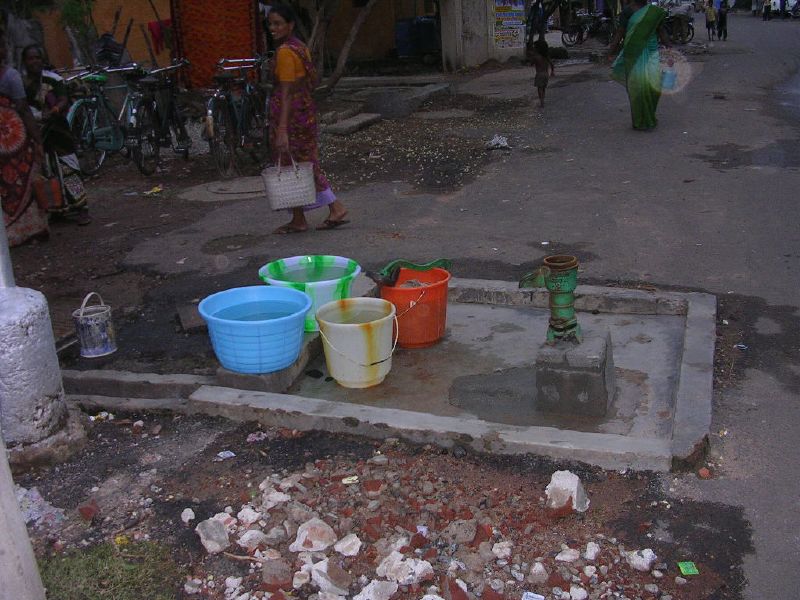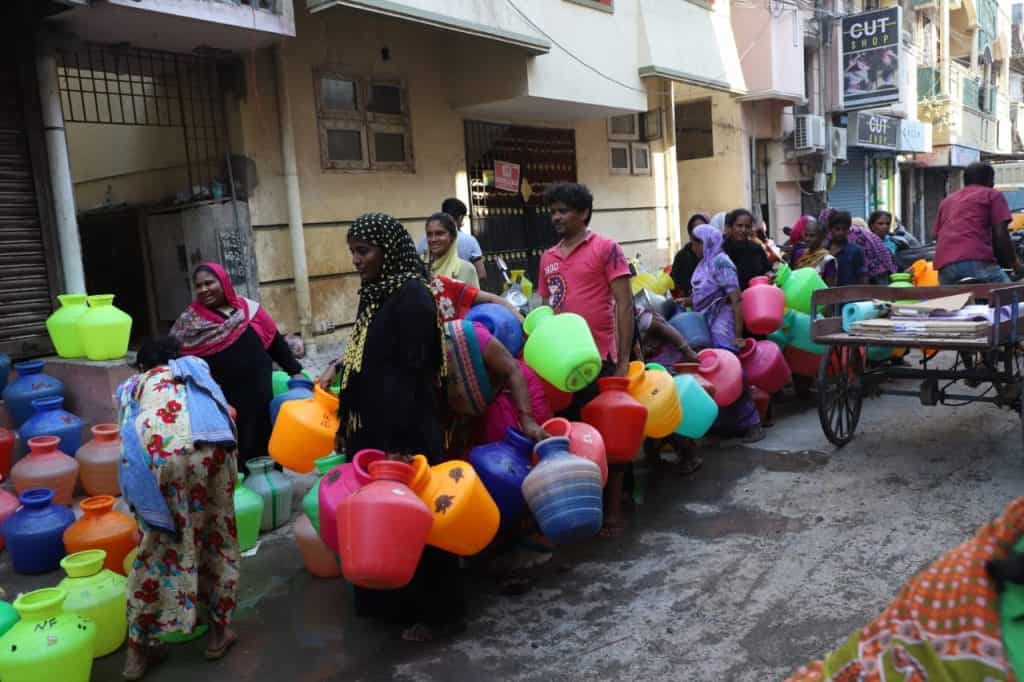Rows of colourful plastic pots lined up before tanker lorries and a sea of people waiting near hand pumps had become defining images of Chennai’s water crisis in the summer of 2019. While the city has seen good monsoons and sufficient water in storage in the years since, little has changed in terms of regular supply for many residents of low-income communities across the city.
“The water crisis we face is an all-seasonal issue and summer only worsens our living conditions,” says L Kamala, a 32-year-old resident of Pulianthope. She starts her day as early as 5 am. She cooks for her family of five members, gets her three children ready for school and her husband for work. By around 9.30 am, she is out on the street carrying plastic pots on hearing the honks indicating the arrival of a water tanker from the Chennai Metropolitan Water Supply & Sewerage Board (CMWSSB).
“This is my routine on most days and my mornings solely revolve around the arrival of the water tanker,” she says. This is an issue faced by many women across the city that is yet to see a solution.
Life revolves around water
The cost paid by Kamala, like many other women in low-income localities, is not only monetary. It is defined in terms of the time they spend waiting for water tankers, the subsequent loss of pay incurred due to waiting, the lost opportunities, and the impact on health caused by carrying the water pots through narrow stairs of multi-storey buildings.
“In case the water tanker arrives a little late, I am unable to report to my job, and I would have to lose a day’s salary. If we fail to get water for one day, then there will be no water for drinking, cooking, washing or cleaning and it will create a mess in the family,” said Kamala, who works as a salesperson at a retail textile shop in Parry’s Corner.
“There are times when we run out of water completely. On such days I ask my husband to buy water from private entities because I cannot run a household without any water. This would create an argument between us and lead to fights in front of our children. Lack of water spoils the whole family’s peace of mind”, she added.
Read more: Seven reasons why Chennai should have seen this water crisis coming
Speaking on the health impact, A Kalaivani, a resident of Jeeva Nagar, said “Women who have undergone surgeries during childbirth or for any other ailments are generally advised not to lift heavy things. However, we are left with no choice. Our husbands leave for jobs early in the day. There is no scheduled time for the tanker to arrive. When the tanker comes, we have to be there to get the water and carry it for two or three floors,” she said.
The water tankers come once every two days to areas like Pulianthope, Jeeva Nagar in Vyasarpadi, KV Park, VOC Nagar and Kannigapuram. Contrary to the Union Ministry of Housing and Urban Affairs’ recommendation for daily water supply of 135 litres per capita in urban areas, entire families in these localities get an average of 100 litres of water once in two days.
“We do not have individual water connections for our households. We neither have bore water facilities. With tanker supply being the only source of water, we solely depend on them,” said G Kavitha, a resident of Pattalam.
If the tankers fail to come for a day or two, then the residents of Pattalam will have to travel for more than a kilometre to Ellai Amman Koil area to fetch water in goods carrier tricycles. Similarly, the residents of Pulianthope too will have to travel for more than a kilometre to carry the water.
Tankers and cans fill the water supply gap
The water supplied in tankers or those fetched from nearby localities are not only used for cooking, cleaning and washing but also for drinking. “Many of the adults in our locality have been used to drinking metro water. However, our kids get sick easily. So we opt to buy water cans now,” said P Mohan from Pulianthope.
Meanwhile, sewage mixed with drinking water supplied through hand pump connections has been a major issue in most parts of Kodungaiyur, Otteri and Pulianthope. “Some six months ago, half a dozen of the residents in our locality suffered from diarrhoea due to contaminated water. They recovered only after hospitalisation. This also forces us to buy water cans now,” added Mohan.
While women in these localities are involved in works like household cleaning, sanitary works, helpers at markets, runs makeshift food stalls and as salespersons, most men are involved in construction works, works as carpenters, plumbers, auto drivers and sanitary workers.
The average monthly income of women would be around Rs 7,000 while the average monthly income of men would be around Rs 15000, but there is very little guarantee they will work through the month. Even the educated young folk in these areas have not been able to find proper employment and are working as food delivery persons with no fixed source of income, the residents said.
“The habit of buying drinking water cans has increased significantly in the past few years. Of this trifle income, a sum of Rs 1500 to Rs 2000 is spent on buying water cans. However, this expenditure has become nearly invisible because when we pay for a single water can (Rs 30 to 35), the amount seems negligible,” Mohan said, adding that the water can suppliers also increased the cost by Rs 5 or Rs 10 during summer.
Read more: Where does the water in your tap come from?
Water supply not at par with growing population
Chennai has avoided widespread summer water shortage with adequate storage in reservoirs after the copious rainfall received last year. But the issues of irregular supply and instances of shortage in low-income communities are yet to be addressed.
The residents in the tenements of Tamil Nadu Housing Board across the city, who have been living there for decades, were allocated the dwelling units based on the then number of family members. ”As years passed, children grew up and became adults and they have their own families now. However, they continue to live in the same houses and the basic infrastructure including water, electricity, sewage lines have not been stepped up for the growing population,” said Isai Arasu, a social activist.
Amirtham A who resides in one such tenement in Thomas Road in T Nagar highlighted how the residents are forced to compete with each other for a turn at the common water pump. “We receive water at odd hours. If you walk the road at 2am or 3am you will find women from the tenement drawing water from the hand pump. We do not get more than 3 or 4 pots once every two days and have to ration the water. During drought years the situation is much worse as fights break out between residents over water.”

The situation is perhaps worse for those residents of resettlement colonies located in the outskirts of the city. “When residents within the city stage a protest seeking adequate water supply, the officials do something to supply water for the time being at least, fearing law and order issues otherwise. However, when residents of resettlement colonies stage a protest, they are left in limbo,” said Isai Arasu.
Officials from Metro Water told Citizen Matters that there is no likelihood of any scarcity for water this summer and the supply chains are working as usual. Speaking on the issue of contaminated water, they said that this would be addressed as and when public complaints were received. However, they did not offer any comments on the issues faced by residents who do not get regular supply.
The way forward for Chennai
S Janakarajan, Professor of Economics (Retired) from the Madras Institute of Development Studies (MIDS, Adyar), said that Chennai should first not be considered a water deficit city because it receives an abundant amount of rainfall compared to other cities across the country. However, the problem arises when drought and flood are dealt with as two different separate issues. “Do not separate drought and flood and then involve in mitigation measures. If you take care of your drought, you will take care of your floods and vice versa. During drought, make sure all the tanks are desilted and cleaned. This will help in conserving water during rains,” he said.
A study conducted by the Mahindra-TERI Centre of Excellence (CoE), a joint research initiative of Mahindra Lifespaces and The Energy and Resources Institute (TERI), which highlighted the potential water challenges in Chennai Metropolitan Area (CMA) makes these following recommendations.
- Propagation and adoption of water conservation practices such as rainwater harvesting, wastewater recycling and reuse, to meet the rising water demand due to rapid demographic changes
- Developing policies and designing measures towards protecting the region’s ecosystems to strengthen both natural and urban water flow systems
- Identifying and filling up data gaps related to groundwater availability, extraction and use by conducting detailed surveys
- Strengthening of the water governance structure and administration; establishing a transparent and participatory mechanism through capacity building and training programmes
The study also highlights the lack of data on per capita consumption and the informal nature of many settlements which make planning for future supply an impossible task leaving many Chennai homes in a precarious situation when it comes to water.
For effective implementation of the recommendations, the study suggests development of an Integrated Water Resource Management (IWRM) along with bottom-up approach, decentralization of water governance structure and strengthening of water-related databases.
